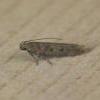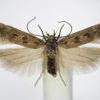35.113 Scrobipalpa salicorniae (Zeller, 1847)
Status and Distribution
Local in coastal and estuarine areas of south and east England, very local elsewhere in England, south Wales, Scotland and Northern Ireland (new in 2024). Apparently absent from Isle of Man and Channel Islands. The moth infrequently disperses inland, possibly in response to hot weather conditions and higher population levels.
Recorded until 2010 as S. salinella in the British Isles, S. salicorniae and S. instabilella belong to a (wider) complex of closely related species (Gregersen and Karsholt (2022). The true Scrobipalpa salinella, as reported in Huemer, P. & Karsholt, O. (2010), Microlepidoptera of Europe, Volume 6, p.179, only occurs in southern Europe.
It would be worthwhile studying the moths habitat requirements, larval characters and foodplant use, together with DNA samples, from this and closely related taxa to contribute towards a wider understanding of this complex group.
Provisional map
Foodplant and Larval Feeding Signs
Salicornia spp. (glassworts), see plant distribution map, Tripolium pannonicum (sea aster), Suaeda spp., including S. maritima (annual sea-blite), Sperguleria spp. including S. media (greater sand-spurrey) or Limonium vulgare (common sea-lavender).
In Europe also noted on Salicornia europaea agg. (common glasswort) and less frequently Atriplex prostrata (spear-leaved orache) and Spergularia salina.
Feeding method varies according to the foodplant, spinning shoots (glassworts), mines galleries (sea aster) or spins leaves and shoots (sea-blite) - for more detail see 'Finding the moth' below.
Habitat
Coastal and Estuarine saltmarshes.
Finding the Moth
Larva: from continental observations on glasswort, spins several shoots or branches together on strong erect plants but, where the plants are small and thinly spread, it lives in a dense silken tunnel on or in the ground and extends a loose web over nearby prostrate branches. On sea aster, the larva makes a series of galleries in the leaves similar to Bucculatrix maritima. The larva of B. maritima has a green dorsal line while that of S. salicorniae has a red dorsal line. On sea-blite the larva spins several leaves or shoots and consumes green parts from within this shelter leaving only the colourless remains.
Adult: can be found flying freely at dusk and comes to light (both MV and Actinic).
Similar Species
Because of the sometimes considerable variation within most saltmarsh inhabiting Scrobipalpa species, identification by wing markings alone will often not be possible. Caution and care are the watchwords for this group.
S. salicorniae is best identified by dissection but breeding through from one of the known foodplants will greatly assist in the process of naming the moth.
When encountering specimens which are smaller than usual or have less extensive dark markings on the wing, particularly those found on the east or south-east coast of England, it may be worh considering the possibility of two additional species found in France. S. spergulariella is associated with Spergularia media (greater sea-spurrey) and is generally smaller at 9-12mm (as opposed to 13-15mm for S. salicorniae). S. halimoniella is intermediate in size betwen these two (at 11-14mm) and feeds on Atriplex portulacoides (sea-purslane). This species has generally plain light grey-brown forewings almost without distinct black markings. Dissection will be an essential part of the identification process should either of these moths be suspected.
More generally with the coastal Scrobipalpa species, if a moth has been bred from a known foodplant, and therefore by inference the time of year when the larva feeds and the nature of its feeding methods have been observed, this information, plus a freshly emerged moth, will allow the number of possibilities to be reduced. If the bred or caught moth is a fresh specimen AND displays the distinctive markings of some species (see below) then an identification without more detailed examination should be possible in many cases.
Those more readily identifiable when freshly emerged by the forewing markings are listed below. However all of these also have variation in their wing markings which, when the obvious features are obscured or worn, will then resemble some other Scrobipalpa species.
Scrobipalpa suaedella - those with an obvious clear pale ochreous dorsal quarter to the forewing.
Scrobipalpa obsoletella - those with the forewing a pale greyish colour lacking any red-brown colouration and appearing paler in the final one-third due to a pale postmedial fascia.
Scrobipalpa ocellatella - those with the prominent angled fascia at three quarters on the forewing and dark markings contrasting with the surrounding paler ground colour.
In cases where there is any doubt, particularly where worn light-trapped specimens are concerned, dissection will be essential to obtain an accurate identification until a good familiarity is built up with the range of species and their markings at a particular site.
Even genitalia differences are often small but are constant between the various species. It is advisable to seek confirmation of identifications by genitalia until familiarity is built up with this genus.
Probably single brooded in Britain from June to early September but there have been suggestions, both in the British Isles and in Europe, of it being at least double brooded. Further research is required in relation to use of specific foodplants.
Earliest: 4th June 2004 (VC11)
Latest: 12th September 1999 (VC14)


_0.jpg)
